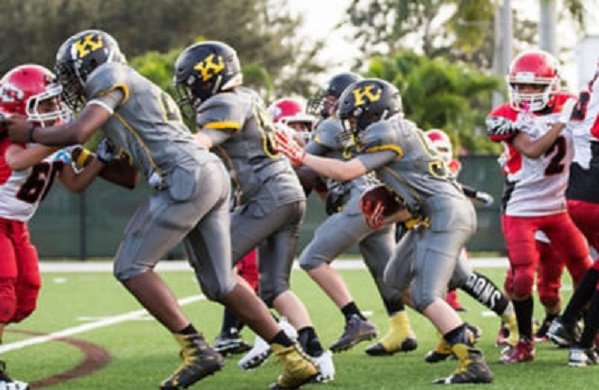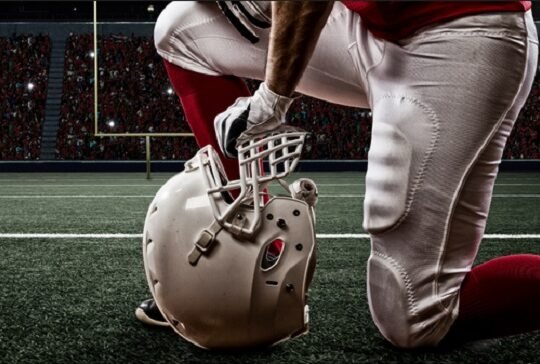A tight end in football is a versatile player who combines the roles of both offensive lineman and wide receiver. Positioned at either end of the offensive line, tight ends are crucial in both blocking and receiving plays. They block for the running back or quarterback on running and passing plays and can also run routes to catch passes. This dual responsibility makes tight ends essential for both protecting the quarterback and advancing the ball downfield. Their size, strength, and agility are key attributes, allowing them to contribute significantly to the team’s offensive strategy.
Tight End in Football: Definition and Role Explained
Tight ends (TEs) play a multifaceted role that combines the responsibilities of both offensive linemen and wide receivers. Positioned at the end of the offensive line, they block for running backs and quarterbacks on running and passing plays, providing crucial protection. Additionally, TEs run routes and catch passes, making them key targets in the passing game. Their versatility requires a unique combination of size, strength, and agility, allowing them to impact the game in various ways, from blocking and protection to receiving and advancing the ball.
Understanding the Tight End Position
Understanding the tight end position in football involves recognizing their dual role on the field. Tight ends (TEs) are positioned at the end of the offensive line and are essential for both blocking and receiving. They block for the running back and quarterback on running and passing plays, offering crucial protection. Simultaneously, TEs run routes and catch passes, acting as key targets in the passing game. This versatility requires a blend of size, strength, and agility, making tight ends valuable assets in both the ground and aerial aspects of the team’s offensive strategy.
Evolution of the Tight End Position
The evolution of the tight end position in football reflects significant changes in the game’s offensive strategies. Initially, tight ends were primarily blockers, positioned on the line to support the running game and protect the quarterback. Over time, their role expanded to include receiving duties, transforming them into versatile players who can both block and catch passes.
Modern tight ends are now expected to possess the size and strength for effective blocking, as well as the speed, agility, and hands to run routes and make crucial receptions. This shift has led to the emergence of dynamic playmakers who can create mismatches against defenses, contributing significantly to both the running and passing attacks. The evolution of the tight end has made the position a cornerstone of modern offensive schemes, offering flexibility and strategic depth.
Role of a Tight End in a Game
The role of a tight end (TE) in a football game is multifaceted, involving both blocking and receiving duties. Positioned at the end of the offensive line, TEs block for running backs and quarterbacks, providing crucial protection and support in the running game. Additionally, they run routes and catch passes, acting as key targets in the passing game. Their versatility requires them to be strong enough to block effectively and agile enough to run routes and make receptions. This dual capability makes tight ends essential to a team’s offensive strategy, contributing to both ground and aerial attacks.
Blocking
Blocking is arguably the most important role of a tight end (TE) in football. Positioned at the end of the offensive line, TEs are crucial for both run blocking and pass protection.
- Run Blocking: TEs block defensive linemen and linebackers to create running lanes for the running back, essential for the success of running plays. Their ability to hold blocks and engage defenders directly impacts the ground game.
- Pass Protection: TEs often assist in protecting the quarterback by blocking edge rushers and providing additional pass protection. This support helps to ensure the quarterback has sufficient time to make accurate throws.
- Effective blocking by TEs requires a combination of strength, leverage, and technique, making them indispensable to the offensive line’s overall effectiveness and the team’s success in both the running and passing games.
Receiving
In addition to blocking, tight ends (TEs) are also crucial as receivers in football. Positioned at the end of the offensive line, TEs often run routes and catch passes, making them versatile offensive threats.
- Receiving Role: TEs serve as key targets for quarterbacks, especially in short to intermediate passing situations. They are often used in play-action passes and red-zone scenarios due to their size and catching ability.
- Mismatches: TEs can create mismatches against smaller defensive backs or slower linebackers, leveraging their size, strength, and agility to gain an advantage.
- Dual Threat: The ability to both block effectively and contribute as a receiver makes TEs valuable assets in an offensive scheme, providing flexibility and unpredictability to the team’s attack. This dual role enhances their importance and impact on the game.
Lining Up
Tight ends (TEs) can line up in various positions on the field, showcasing their versatility:
- Inline: Positioned next to the offensive tackle on the line of scrimmage, TEs block for both the running game and pass protection.
- Slot: Lined up off the line of scrimmage, usually between the tackle and wide receiver, allowing for easier route running and creating mismatches against defenders.
- Split Out: Positioned wider than a traditional tight end, near the sideline, similar to a wide receiver, enhancing their role in the passing game.
- Motion: TEs can move before the snap to different positions, aiding in confusion for the defense and creating favorable matchups.
This flexibility allows TEs to adapt to various offensive schemes, contributing both in blocking and receiving capacities, and maximizing their impact on the game.
Red Zone
Tight ends (TEs) are particularly effective in the red zone due to their unique attributes and positioning.
- Size and Strength: TEs typically possess a combination of size and strength that makes them valuable targets for short-yardage plays and goal-line situations.
- Mismatches: Their size and physicality create mismatches against smaller defensive backs or slower linebackers, making it easier for them to secure catches in tight spaces.
- Reliable Targets: TEs often have reliable hands and can provide a reliable target for quarterbacks in high-pressure situations. Their ability to box out defenders and make contested catches enhances their effectiveness in the red zone.
- Versatility: TEs can run a variety of routes and are utilized in various formations, making them difficult to defend against when the field is compressed. Their role becomes crucial in converting red-zone opportunities into touchdowns.
Extra Blocker
Finally, tight ends (TEs) are often used as extra blockers on running plays. Positioned next to the offensive line, TEs provide additional support by blocking defensive linemen and linebackers, helping to create running lanes for the running back. Their involvement as extra blockers enhances the effectiveness of the running game, contributing significantly to the success of offensive plays by adding strength and protection at the line of scrimmage
Famous Tight Ends in NFL History
Several tight ends have left a significant mark on NFL history:
- Tony Gonzalez: Known for his exceptional receiving skills, Gonzalez retired as the NFL’s all-time leader in receptions, receiving yards, and touchdowns for a tight end.
- Jerry Rice: While primarily a wide receiver, Rice occasionally lined up as a tight end and set numerous receiving records that stand out in NFL history.
- Rob Gronkowski: Renowned for his physicality and playmaking ability, Gronkowski won multiple Super Bowls with the New England Patriots and Tampa Bay Buccaneers, and set numerous records for tight ends.
- Shannon Sharpe: A key player for the Denver Broncos and Baltimore Ravens, Sharpe was known for his receiving prowess and won three Super Bowls during his career.
- Kellen Winslow Sr.: A pioneer at the position, Winslow was known for his receiving skills and athleticism, making him a standout player in the 1980s and earning a place in the Hall of Fame.
These tight ends are celebrated for their impact on the game, contributing significantly to their teams’ successes and shaping the role of the tight end in the NFL.
Physical and Athletic Traits of a Tight End
The tight end position in football requires a unique combination of skills and physical attributes:
- Size and Strength: Tight ends need to be physically imposing, with the strength to block defensive players and the size to create mismatches against smaller defenders.
- Agility and Speed: Despite their size, tight ends must be agile and quick to effectively run routes, make catches, and create separation from defenders.
- Blocking Ability: They must excel in blocking for both running plays and pass protection, using technique and leverage to assist the offensive line and protect the quarterback.
- Receiving Skills: Tight ends need reliable hands, good route-running abilities, and the capability to catch passes in traffic, making them key targets in the passing game.
- Versatility: They must adapt to various roles, from lining up on the line of scrimmage to split out wide, contributing to both the running and passing aspects of the offense.
This blend of skills and attributes allows tight ends to be effective in multiple facets of the game, making them versatile and valuable assets to their teams.
Strategic Use of the Tight End Position
The strategic use of the tight end position is integral to a football team’s offensive strategy, leveraging the player’s unique skills to enhance performance:
Versatility in Formation: Tight ends can be used in various formations, such as inline next to the offensive tackle, in the slot, or split out wide, creating mismatches and confusing defenses.
- Blocking and Protection: TEs provide crucial support in blocking schemes for both running plays and pass protection, helping to establish the running game and protect the quarterback from pressure.
- Red Zone Target: Their size and catching ability make tight ends valuable targets in the red zone, where their presence can be used to exploit mismatches against smaller defenders or to create space for other players.
- Play Action: Tight ends are often involved in play-action passes, where their blocking responsibilities can draw defenders in, opening up opportunities for them to receive passes or for other players to exploit the defense.
- Route Running: Effective route running by tight ends can help in converting third downs and achieving crucial yardage, using their agility and hands to make key receptions in critical moments.
- Creating Mismatches: The combination of size, speed, and receiving skills allows tight ends to create mismatches against linebackers and defensive backs, making them a strategic asset in both short and long-yardage situations.
By strategically utilizing tight ends in these ways, teams can maximize their offensive efficiency and adapt to various defensive schemes.
Tight End Position: A Basketball Connection
The tight end position in football has a notable connection to basketball, reflecting similar skills and attributes:
- Physical Attributes: Like basketball players, tight ends often possess a combination of size, strength, and agility. Their physicality allows them to excel in both blocking and receiving roles.
- Hand-Eye Coordination: Tight ends need excellent hand-eye coordination to catch passes in traffic, a skill that parallels the catching and shooting abilities of basketball players.
- Agility and Footwork: The agility and quick footwork required for running routes in football are similar to the movement and positioning skills needed on the basketball court.
- Rebounding and Blocking: Just as basketball players use their size and strength to rebound and block shots, tight ends use these attributes to block defenders and create space on the field.
- Spatial Awareness: Both positions require an understanding of spatial positioning. Tight ends must navigate the field and find open areas, similar to how basketball players move to get open shots or create plays.
- Physicality and Toughness: The physical nature of football and basketball demands a high level of toughness and resilience, whether it’s absorbing hits on the field or enduring physical play on the court.
These shared traits highlight how skills developed in basketball can translate effectively to the tight end position in football, making it a dynamic and multifaceted role.
Frequently Asked Questions
Here are six frequently asked questions (FAQs) about the tight end position in football, along with their answers:
What is the primary role of a tight end?
The primary role of a tight end is to serve as both a blocker and a receiver. They assist in blocking for the running game and pass protection, while also running routes and catching passes to contribute to the team’s passing attack.
How does a tight end differ from a wide receiver?
Unlike wide receivers, who are primarily focused on catching passes and running routes, tight ends have additional responsibilities in blocking. Tight ends are generally larger and stronger, combining elements of both offensive linemen and receivers.
What skills are essential for a tight end?
Essential skills for a tight end include strong blocking ability, reliable hands for catching passes, agility for running routes, and the physicality to handle both blocking and receiving duties effectively.
Can tight ends be used in the red zone?
Yes, tight ends are often used in the red zone due to their size and catching ability. They are valuable targets for short-yardage and goal-line situations, where their physical presence can help secure key receptions.
What are some common formations for tight ends?
Tight ends can line up in various formations, including inline (next to the offensive tackle), in the slot (between the tackle and wide receiver), or split out wide. This versatility allows them to adapt to different offensive schemes.
How has the role of tight ends evolved over time?
Historically, tight ends were primarily focused on blocking. However, the role has evolved to include more receiving duties. Modern tight ends are expected to excel in both blocking and receiving, making them versatile and dynamic players on the field.





